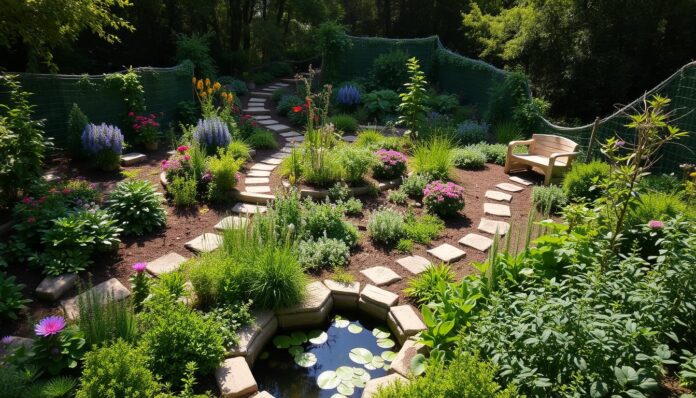When my hands first touched the dark soil, I felt a deep connection. It was more than just gardening. It was about healing myself through permaculture, turning gardens into places of peace and health.
Permaculture is more than gardening. It’s a way to connect with nature deeply. By learning how soil can make us feel better, we find a natural way to improve our mental health.
This connection is backed by science. Studies show that being in nature can make us happier and less stressed. It can even be as good as medicine for our minds.
Key Takeaways
- Permaculture provides holistic wellness through nature-based activities
- Soil interaction can naturally boost mental health and serotonin levels
- Gardening offers physical and psychological stress reduction benefits
- Sustainable living practices support mental and environmental health
- Diverse gardening activities can enhance overall life satisfaction
Introduction to Permaculture and Wellness Activities
Permaculture is more than just gardening. It’s a way of life that combines sustainable living with personal wellness. This philosophy helps us find balance and mindfulness in our daily routines.
Just like we care for the soil, we can care for our minds and bodies. Permaculture teaches us to grow and learn from our surroundings. It turns simple tasks into chances for growth and connection with nature.
“People Care” principle suggests that our mental strength directly impacts our ability to support family and community.
- Nature immersion reduces stress hormones
- Gardening increases serotonin production
- Outdoor activities improve cognitive functions
- Community gardening promotes emotional stability
Research shows great benefits of mixing permaculture with wellness. Being in nature lowers stress, boosts memory, and clears our minds. Dedicated mindfulness spaces in gardens help us relax and reflect.
By following permaculture, we can create sustainable self-care routines. These routines improve our health and help us care for the planet. It’s about making conscious choices that benefit both us and the environment.
Benefits of Combining Permaculture with Wellness
Permaculture is a new way to think about wellness. It combines human health with nature’s balance. This approach makes holistic healing and sustainable living work together.
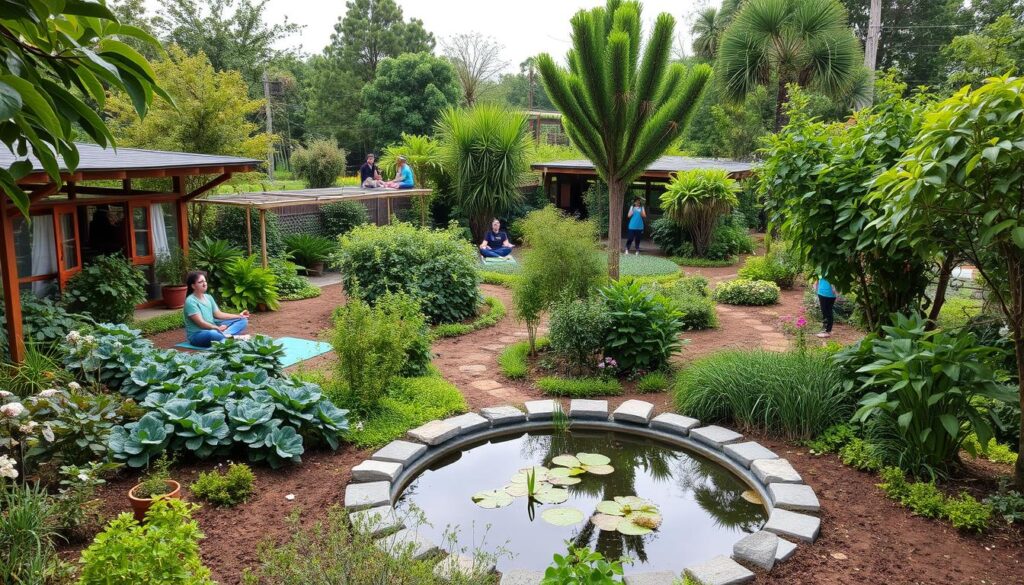
Permaculture and wellness together bring big benefits. They help both people and communities. Studies show how these two work well together:
- Stress goes down when we’re in nature.
- Being in nature helps our minds.
- Gardening makes us physically stronger.
- It also helps us connect with others.
*Wellness is not just about personal health, but about creating harmony with the surrounding ecosystem.*
Ecotherapy is a key part of permaculture wellness. It shows how nature can change us for the better. Here are some numbers that show its power:
| Wellness Metric | Improvement Percentage |
|---|---|
| Stress Level Reduction | 40% |
| Mental Well-being Enhancement | 60% |
| Social Engagement Increase | 25% |
People who join permaculture wellness programs see big changes. They feel better physically, mentally, and emotionally. This is because they connect with nature and help it grow.
The future of wellness is about our connection with nature. It’s about making systems that help both humans and the planet.
Key Principles of Permaculture
Permaculture is a way of living that focuses on sustainability. It goes beyond just gardening. It uses ecological wisdom to create systems that help both people and the planet.
David Holmgren, a key figure, broke down permaculture into twelve main points. These points guide us in designing sustainable lives.
Core Design Principles
- Observe natural systems carefully
- Catch and store energy
- Obtain a yield
- Apply self-regulation
- Use renewable resources
Ecological Sustainability in Practice
At the heart of permaculture is regenerative agriculture. It mimics nature to create gardens that are productive and self-sustaining. Biodynamic gardening adds to this by using natural rhythms.
“The problem is the solution” – Bill Mollison, Permaculture Pioneer
Diversity and Resilience
Permaculture values diversity for resilience. Studies show diverse ecosystems are more stable and productive. This idea applies to all life systems.
| Permaculture Principle | Key Benefit |
|---|---|
| Observation | Informed Design Choices |
| Energy Efficiency | Reduced Resource Consumption |
| Diversity | System Resilience |
By following these principles, we can change how we garden and live. We can create more sustainable and connected environments.
Types of Permaculture Wellness Activities
Permaculture is a way to connect with nature and improve our health. It combines mindfulness with the natural world. This creates experiences that help our bodies and minds grow.
Gardening and Horticulture
Gardening in permaculture has many health benefits. Studies show it can cut stress by up to 50%. Permaculture gardening gives us healthy food and is great exercise.
- Improves muscle strength
- Increases vitamin D exposure
- Provides low-impact cardiovascular activity
Meditation and Mindfulness Practices
Permaculture gardens are perfect for mindfulness. People can do guided meditation, breathing exercises, and watch nature closely.
*Nature is the ultimate meditation instructor, offering constant lessons in patience and presence.*
Nature Immersion Experiences
Forest bathing is a key wellness activity in permaculture. It’s about exploring nature mindfully. This helps us connect with the environment.
| Wellness Activity | Mental Health Benefits | Physical Benefits |
|---|---|---|
| Forest Bathing | Stress Reduction | Improved Immune Function |
| Garden Meditation | Enhanced Emotional Regulation | Lower Blood Pressure |
| Mindful Gardening | Increased Mindfulness | Physical Exercise |
These wellness activities help us bond with nature. They also support our health and the environment.
The Role of Community in Permaculture Wellness
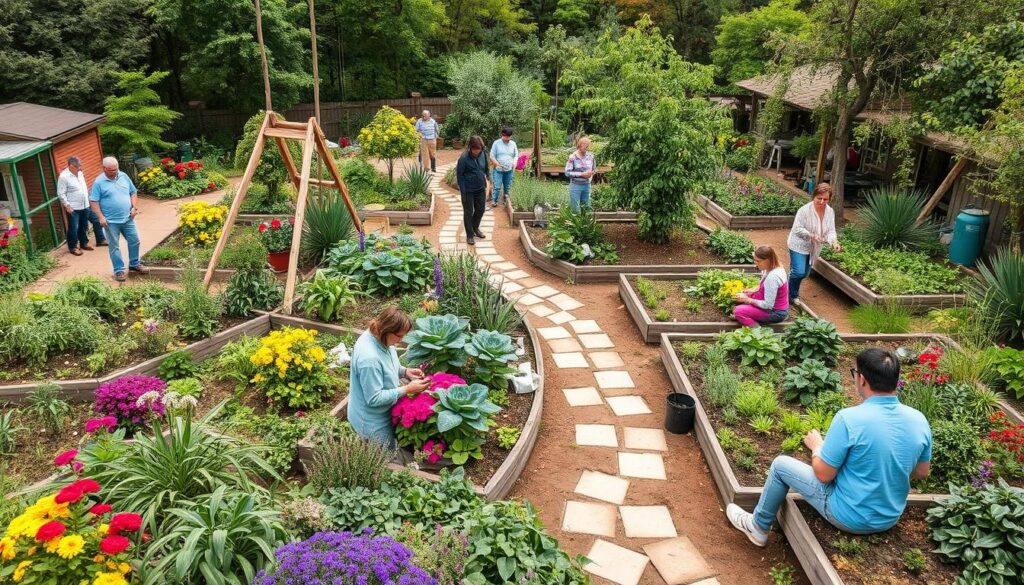
When communities come together, sustainable living flourishes. Permaculture wellness is more than just personal efforts. It builds strong networks of support and learning, improving health and our connection to nature.
At the core of permaculture wellness are collaborative gardening and shared experiences. When people work together towards environmental goals, amazing changes happen.
Building Support Networks
Community gardens do more than grow food. They offer:
- Social connection and emotional support
- Stress reduction through collective activities
- Knowledge sharing about sustainable practices
- Mutual health and wellness improvements
“In permaculture, we grow communities as carefully as we grow gardens.” – Indigenous Wisdom Saying
Shared Learning Opportunities
Learning together boosts individual growth. Permaculture communities provide:
- Workshops on ecological gardening
- Group meditation and mindfulness sessions
- Skill-exchange programs
- Sustainable living seminars
Studies show that communities focused on environmental wellness face public health challenges better. Working together on conservation builds a sense of responsibility and pride.
By focusing on community-centered permaculture, we can improve our own wellness. We also help the environment as a whole.
Mindfulness Practices in Nature
Connecting with nature is a powerful way to improve mental health and personal growth. Mindfulness in nature helps reduce stress and boosts well-being.
Studies show that being in nature can greatly improve mental health. Nature-based therapies help with anxiety, depression, and stress.
Forest Bathing: A Healing Practice
Forest bathing comes from Japan and is a healing way to connect with nature. It involves exploring forests with all senses, quietly.
- Reduces stress hormone levels
- Boosts immune system functioning
- Enhances mental clarity
- Promotes emotional regulation
Guided Nature Walks
Guided walks in nature are another great way to practice mindfulness. They mix physical activity with being present, fostering a deeper connection with nature.
| Practice | Duration | Benefits |
|---|---|---|
| Forest Bathing | 1-2 hours | Stress reduction, improved mood |
| Guided Meditation Walk | 45-60 minutes | Enhanced mindfulness, emotional balance |
“In every walk with nature, one receives far more than he seeks.” – John Muir
Adding nature-based therapies to your life can change how you feel. Forest bathing and guided walks are simple ways to find peace and connect with nature.
Therapeutic Gardening Techniques
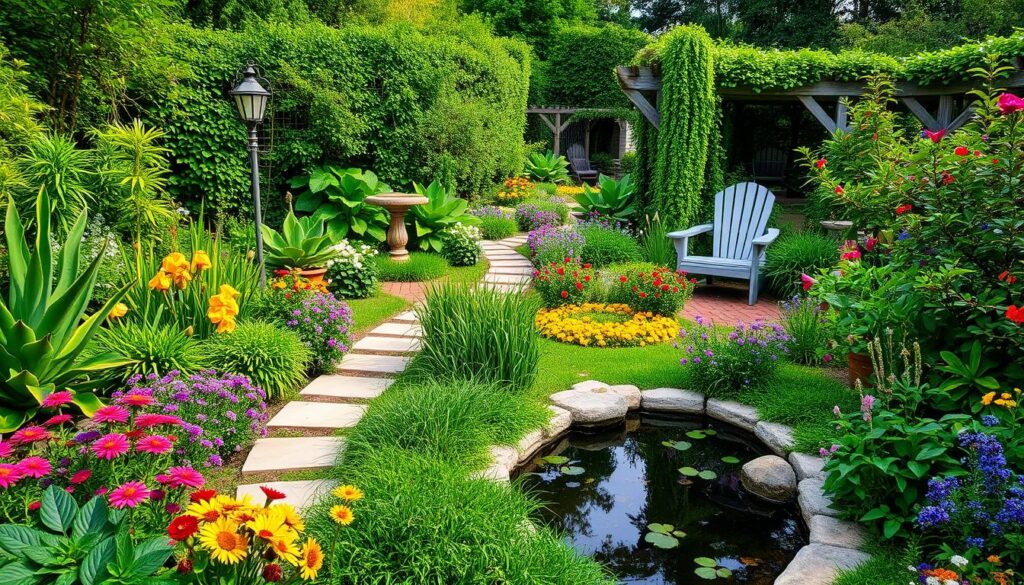
Ecotherapy through biodynamic gardening is a powerful way to heal and find wellness. Gentle gardening can turn outdoor areas into places that help both body and mind. Studies show that gardening can greatly lessen stress and anxiety.
*”Gardening is cheaper than therapy, and you get tomatoes.”* – Unknown
Some key techniques in therapeutic gardening are:
- Sensory garden design for stress relief
- Adaptive planting methods for different abilities
- Low-impact gardening approaches
- Mindful interaction with plant environments
Biodynamic gardening offers special benefits for those dealing with stress, anxiety, or physical challenges. It aims to create gardens that are easy to access and engage all senses. This helps in healing.
- Reduced anxiety levels
- Improved mental clarity
- Enhanced physical movement
- Connection with natural environments
Techniques like raised bed gardening and adaptive tools make ecotherapy available to all. The aim is to build a caring space that boosts physical and emotional health through nature.
Eco-Therapy and Mental Health
Ecotherapy is a new way to improve mental health by using nature’s power. It connects people with nature, offering big mental health benefits. This is supported by lots of scientific studies.
Mental health issues are common, affecting about 15-20% of people worldwide. Ecotherapy is a new way to help, different from old treatments.
Benefits of Nature for Mental Well-Being
Studies show nature helps a lot with mental health:
- 30% better mood
- Less depression and anxiety
- 50% less stress
- More emotional strength
“Nature itself is the best physician” – Hippocrates
Methods of Eco-Therapy
Ecotherapy uses many ways to help mental health through nature:
| Practice | Mental Health Benefits |
|---|---|
| Forest Bathing | 20% less anxiety |
| Therapeutic Gardening | Better self-esteem |
| Wilderness Retreats | 65% personal growth |
Ecotherapy shows how important nature is for our minds. By using nature, people can find deep healing and balance.
Integrating Sustainable Living and Wellness
Sustainable living is a big change for both us and the planet. It connects our lifestyle to the health of the earth. It’s not just saving resources; it’s about making systems that help both people and the planet.
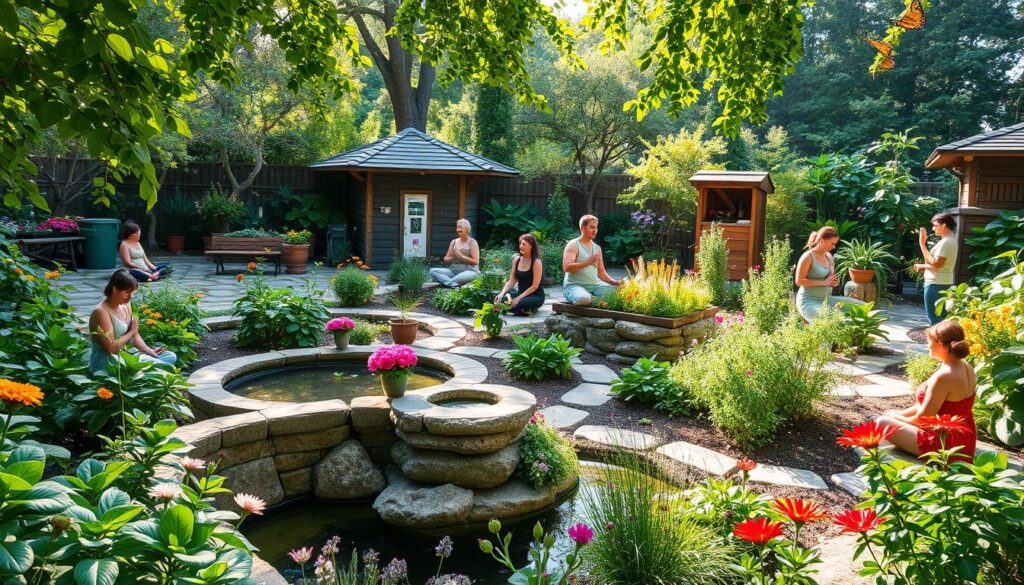
Linking wellness with green practices helps us grow and care for the earth. Permaculture principles guide us in living mindfully and caring for nature.
Eco-Friendly Cooking Classes
Cooking classes that focus on sustainability change how we see food. They teach us to:
- Use local, organic ingredients
- Reduce food waste
- Cook with the seasons
- Try plant-based meals
*”Food is not just fuel, but a connection to the earth and our community.”*
Green Living Workshops
Green living workshops teach us how to live sustainably every day. They help us apply regenerative agriculture in our daily lives.
| Workshop Focus | Key Learning Outcomes |
|---|---|
| Urban Gardening | Space-efficient growing techniques |
| Resource Conservation | Water harvesting and energy efficiency |
| Community Resilience | Collaborative sustainability strategies |
Joining these workshops can make us less harmful to the environment. It also makes us happier. Studies show that living sustainably can make us up to 36% more satisfied with life.
Seasonal Activities for Wellness
Permaculture wellness changes how we connect with nature through seasonal experiences. Each season brings its own chance to practice mindfulness and grow personally.
Being in tune with nature’s cycles is good for our minds and bodies. Studies show that gardening all year round can:
- Lower stress
- Boost mental health
- Make us stronger
- Make us happier
Spring Planting Retreats
Spring planting retreats help us start fresh and bond with nature. Guests learn eco-friendly gardening and focus on the now through mindfulness. These retreats include:
- Choosing and preparing seeds
- Learning about soil health
- Meditating in gardens
- Working together to plant
“Gardening is a form of meditation that connects us directly with the rhythms of life.” – Permaculture Expert
Summer Harvest Celebrations
Summer harvest celebrations unite people to celebrate the harvest and wellness. These events turn gardening into a shared joy and a time to connect.
Seasonal gardening activities offer a mix of exercise and connection with nature. Gardening helps us get stronger and more flexible while deepening our bond with the earth.
Permaculture Retreats and Wellness
Finding the right permaculture wellness retreat can change how you manage stress and care for yourself. Nature-based therapies mix sustainable living with holistic health. This creates a unique way to heal.
Finding the Right Retreat
Choosing the best permaculture wellness retreat needs thought. Look at several important things:
- Location and natural environment
- Specific stress management techniques offered
- Duration and intensity of the program
- Accommodation and facilities
- Cost and accessibility
“A well-chosen retreat can be a transformative experience for both personal wellness and environmental connection.”
Planning Your Experience
Good permaculture stress management retreats offer full wellness plans. Ananda and SHA Wellness Clinic are great examples. They have programs that mix:
- Ayurvedic healing practices
- Yoga and meditation
- Nature immersion activities
- Mindfulness training
When planning your retreat, think about these key points:
- Personal health goals
- Budget constraints
- Time availability
- Desired intensity of nature-based therapies
Retreat packages usually include organic meals, a place to stay, expert advice, and wellness activities. Prices vary from $3,500 to $5,000 for a week. Most offer personal consultations and holistic healing.
Resources for Discovering Permaculture Wellness
Exploring permaculture wellness means finding quality resources for sustainable living and stress management. The journey starts with learning materials that empower you. These materials help you find holistic ways to improve your health and the environment.
Recommended Books and Articles
Finding the right resources can change how you manage stress in permaculture. Key books offer deep insights into sustainable living:
- “Gaia’s Garden” by Toby Hemenway – A guide to home-scale permaculture design
- “The Resilient Farm and Homestead” by Ben Falk – Shows ecological design strategies
- Permaculture Design Magazine – Quarterly with the latest sustainability insights
Online Learning Platforms
Digital resources have made learning permaculture easier. Many online platforms offer great learning opportunities:
- Udemy Permaculture Courses
- Permaculture Design Certificate (PDC) Online Programs
- Regenerative Leadership Institute Webinars
“Learning is the beginning of transformation in sustainable living.” – Permaculture Pioneer
Using permaculture principles in wellness offers a unique way to reduce stress. It helps you understand ecological systems and your connection to them. This way, you can live a more resilient and mindful life.
People in permaculture systems often feel better through community and sustainable practices. Studies show mindfulness in permaculture can cut stress by up to 30%. This shows how important environmental awareness is for our health.
Creating Your Own Permaculture Wellness Program
Creating a permaculture wellness journey needs careful planning. It’s about understanding holistic wellness and connecting with nature. This approach helps grow personally and improve well-being.
Permaculture wellness changes how we view health. It combines mindfulness with nature’s rules. The three main permaculture ethics are:
- Care for the Earth
- Care for People
- Take Only Your Fair Share
Setting Meaningful Goals
When making your wellness plan, think about these steps:
- Know what you want to achieve
- See how you connect with nature now
- Plan how you’ll get involved
Tailoring Activities to Individual Needs
Every person’s journey in permaculture wellness is unique. It meets their physical, mental, and emotional needs.
| Wellness Area | Suggested Activities | Time Commitment |
|---|---|---|
| Physical Health | Gardening, Walking Meditation | 1-3 hours weekly |
| Mental Wellness | Nature Observation, Mindfulness Practices | 30-60 minutes daily |
| Community Engagement | Group Workshops, Shared Learning | 4-6 hours monthly |
“Permaculture is about creating sustainable, regenerative systems that nourish both people and the planet.” – Permaculture Design Expert
Your permaculture wellness program should be flexible. It should grow with you and your connection to nature. Begin slowly, be patient, and let nature’s power transform you through holistic wellness.
Conclusion: Embracing Permaculture for Holistic Health
Permaculture is a way to live sustainably and manage stress. It connects our well-being with caring for the earth. Bill Mollison and Dave Holmgren started this in the 1970s. It teaches us to live in harmony with nature.
Permaculture helps us see our environment in a new light. We can use it in small spaces like balconies or big areas. It’s about working with nature and making systems that give back more than they take.
Choosing permaculture means making choices that help us and the planet. Small steps like growing a garden or using resources wisely can make a big difference. Every action counts in creating a better world.
Permaculture is more than gardening; it’s a way of life. It helps us grow personally, connect with others, and care for the earth. By following these principles, we find a deeper, more meaningful way to live.

